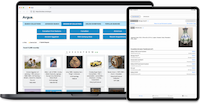Museum Collections Online with Accessibility Principle 1: Perceivable

Rachael Cristine Woody
This week will begin our review of the World Wide Web Consortium (W3C®) technical standards set forth in the Web Content Accessibility Guidelines (WCAG) Version 2.1, Level AA.
You may want to read our previous post Accessibility Standards for Museum Collections Online
Using the guidance and success criteria outlined by the WCAG, we will explore how it can be applied to museum collections online as facilitated by the museum Collections Management System (CMS).
WCAG 4 Principles
The WCAG Version 2.1 is built with 4 core principles:
- Perceivable: People are able to take in information by seeing and hearing.
- Operable: People can provide input through typing or by voice.
- Understandable: Using plain, easy to follow language.
- Robust: Able to apply different assistive technologies.
Each of the guidelines and success criteria we explore fall under one of these four principles. As the DOJ has selected WCAG Version 2.1, Level AA as the public services standard, this series will use that version as a guidepost for discussing how to deliver accessibility for museum collections online. Today’s post will feature Principle 1: Perceivable.
Principle 1: Perceivable
Information published by the museum CMS to the online portal and any website interface components must be presented to users in a way they or the assistive technologies can perceive.
Text Alternatives: Providing a text alternative to non-text content; for museum collections online, this is specific to the non-text assets (e.g., images) of the museum collection.
Time-based Media: Descriptive text should be paired with non-text digital assets presented within the museum collections online. Specifically, this should include captions and audio descriptions.
Adaptable: Conveyance of information and structure for CMS navigation, object relationships, and the interpretation of basic search and advanced search features that require user input.
- Information and Relationships: Object information, information structure, and the object’s relationship to other objects and website content are clearly conveyed through presentation, programmatically determined, or available in text form.
- Meaningful Sequence: For objects and information presented in an intentional sequence (e.g., a digital exhibit) the sequence can be correctly determined programmatically.
- Sensory Characteristics: The presentation of collections online and navigation do not rely solely on sensory characteristics; defined as: shape, color, size, visual location, orientation, or sound.
- Orientation: The collections online interface isn’t restricted to one display orientation.
- Identify Input Purpose: The ability of the user to correctly interpret the purpose of an input, such as advanced search fields.
Distinguishable: Text, navigation, and assets are distinguishable in their presentation online, as published via the museum CMS.
- Use of Color: Colors presented by the CMS can’t be the only visual method of communicating information, directing an action, soliciting a response from the user.
- Audio Control: Audio assets presented online by the CMS has a mechanism to pause or stop the media, or there’s an ability to control the volume.
- Contrast (Minimum): Text and images published online by the CMS are at least 4.5:1 (with some noted exceptions).
- Resize Text: Navigation text and object data published by the CMS can be resized in the browser (without assistive technology) to 200% while maintain all CMS public portal navigation and functionality.
- Images of Text: Real text (as opposed to images of text) should be used at all times to convey navigation and object data published online.
- Reflow: Collections online content is presented without requiring scrolling in two dimensions to see the full information and functionality available.
- Non-text Contrast: Colors used on the website should have a contrast ratio of at least 3:1 against adjacent colors.
- Text Spacing: Text displayed in the collections online portal should support the following without loss of information or functionality:
- Line height (line spacing) to at least 1.5 times the font size;
- Spacing following paragraphs to at least 2 times the font size;
- Letter spacing (tracking) to at least 0.12 times the font size; and
- Word spacing to at least 0.16 times the font size.
- Content on Hover or Focus: If the collections online website offers hover or focus capability it should be dismissible as well as persistent if hover or focus is removed.
Conclusion
This concludes our review of the first principle: Perceivable. Please join us next week for our coverage of Principle 2: Operable.
Notice
Copyright of the World Wide Web Consortium (W3C®). This document includes materials copied or derived the Web Accessibility Initiative (WAI) website. Specific resources are credited below, in accordance with the W3C’s Using WAI Material: Permission to Use with Attribution policy and specifications for a W3C Document License.
Citation 1: Web Content Accessibility Guidelines (WCAG) 2.1. W3C Recommendation 21 September 2023. Editors: Andrew Kirkpatrick (Adobe), Joshue O Connor (Invited Expert, InterAccess), Alastair Campbell (Nomensa), and Michael Cooper (W3C). Copyright © 2020-2023 World Wide Web Consortium. W3C® liability, trademark, and document use rules apply.
Citation 2: Introduction to Understanding WCAG (Version 2.1). Updated 20 June 2023. Developed by Accessibility Guidelines Working Group (AG WG) Participants (Co-Chairs: Alastair Campbell, Charles Adams, Rachael Bradley Montgomery. W3C Staff Contact: Michael Cooper). Copyright © 2023 World Wide Web Consortium. W3C® liability, trademark, and document use rules apply.
The content was developed as part of the WAI-Core projects funded by U.S. Federal funds. The user interface was designed by the Education and Outreach Working Group (EOWG) with contributions from Shadi Abou-Zahra, Steve Lee, and Shawn Lawton Henry as part of the WAI-Guide project, co-funded by the European Commission.
Citation 3: How to Meet WCAG (Quick Reference). Updated 12 Nov 2023. Version 3.5.1. Lead Developer: Eric Eggert (W3C). Project Lead: Shadi Abou-Zahra (W3C). Previous editors and developers: Gregg Vanderheiden, Loretta Guarino Reid, Ben Caldwell, Shawn Lawton Henry, Gez Lemon. Copyright © 2023 W3C® (MIT, ERCIM, Keio, Beihang) Usage policies apply.
The 2023 redesign was developed by the Education and Outreach Working Group (EOWG) and the Web Content Accessibility Guidelines Working Group (WCAG WG), with support from the WAI-DEV project, a project of the European Commission IST Programme.

Rachael Cristine Woody
To learn more, please join us for the companion webinar Accessibility Standards for Museum Collections Online, Wednesday, July 31 at 11 a.m. Pacific, 2 p.m. Eastern. (Can’t make it? Register anyway and we will send you a link to the recording and slides afterwards). Register now.
**Disclaimer: Any in-line promotional text does not imply Lucidea product endorsement by the author of this post.
Never miss another post. Subscribe today!
Similar Posts
Museum Forecast 2026: Federal Policy, Revenue Pressure, and the Role of Professional Organizations
In her 7th annual Museum Forecast, Rachael Woody reveals her predictions, hopes, and concerns for the museum industry in 2026.
From Preservation to Resilience: An Introduction to Building Resilient Digital Collections
Preserving a digital collection is a job that is never done. But what if we shifted our focus from preservation to building digital resilience?
Client Spotlight: MacLaren Art Centre Goes Beyond Collections Care to Access and Growth
“As our needs evolved, it became clear that our existing CMS was no longer working for us. Not only do we need to perform basic collections care, we need a system that will support public access, enable growth, and match our innovative strategies.”
Museum Collections Online: Digital Storytelling Blog Series Roundup
An overview of 10 blog post series that highlight how museums can leverage online collections and digital storytelling platforms, strategies, tools, and best practices.





Leave a Comment
Comments are reviewed and must adhere to our comments policy.
0 Comments